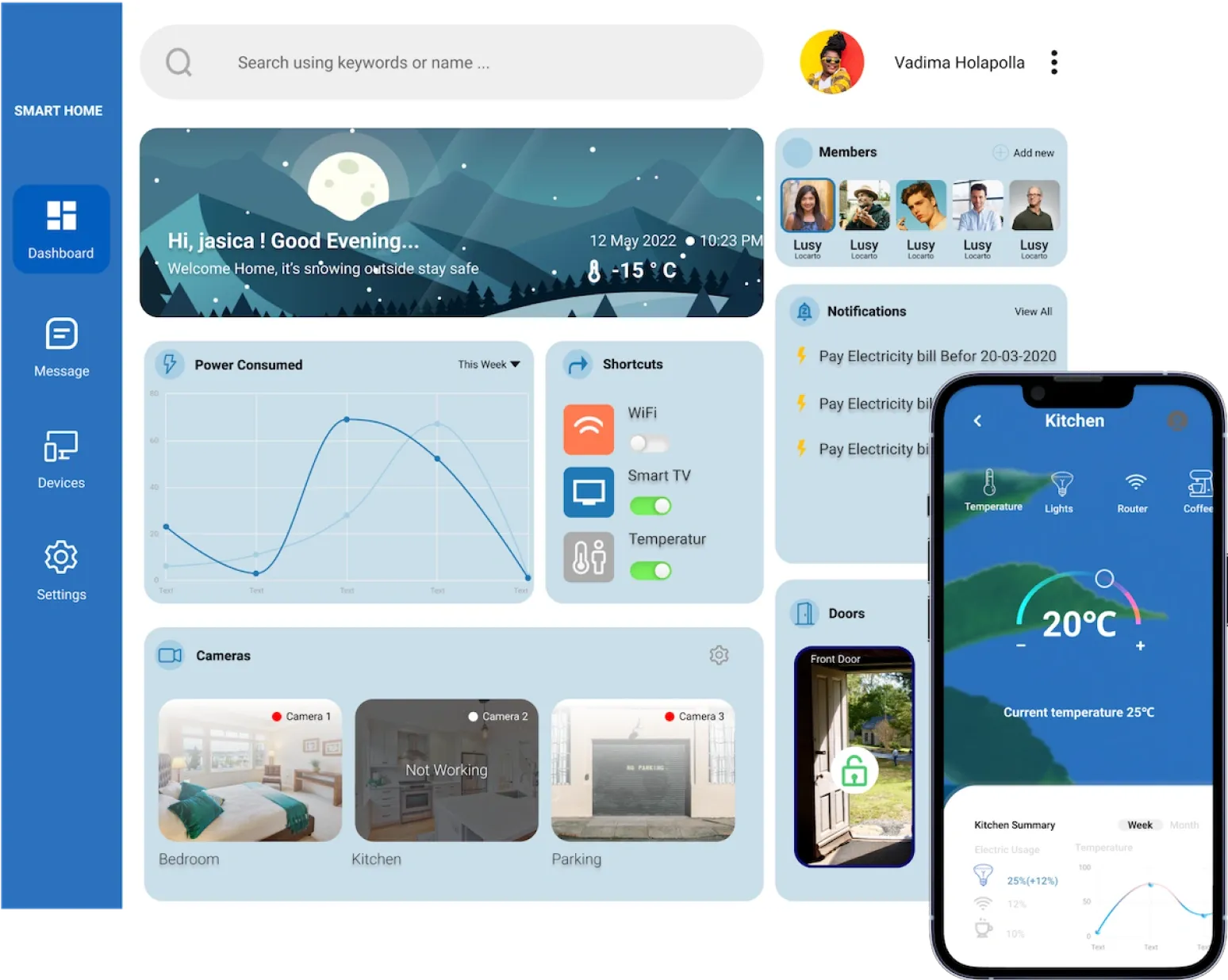
IOT DEVICE MANAGEMENT SOFTWARE
A robust, agile, and secure application for streamlined IoT device control and monitoring.
36%
annual enterprise revenue boost
4X
faster IoT device management
27%
fewer negative user reviews
Client
Our client is an established enterprise-scale U.S. company that provides healthcare services, including caring for the sick, senior care, and emergency aid for over 80,000 users across the country. The provision of such services implies the use of smart IoT devices that help monitor patients’ health conditions.


Challenge
The project we delved into marked a pivotal change in the client’s business. The company was striving to scale up its possibilities by bringing together employed smart devices in a single unit managed by a robust IoT platform. To optimize device monitoring processes, the client opted for the development of an iOS-based application. The aspects required to be implemented in the IoT device management platform included:
- Various forms of device management – voice control, precoded settings.
- Tracking of active work and shutdown periods.
- Real-time indicator monitoring and measurement.
- Periodical reporting.
- In-app indicator-based notifications.

Got a similar software development project on your mind?
Estimate a precise timeframe for its implementation.
Team
1
Project Manager
1
Business Analyst
1
Team lead
1
Data Engineer
7
Developer Engineers
3
QA Testers

Development process
Requirements gathering and processing
As a company skilled in providing IoT software development services, we know that great device management apps always start with profound project research. External studies are essential for freshening up awareness about the latest available strategies, features, and solutions that could be applied to a particular project. Internal research, on the other hand, implies carrying out interviews with the client and the company’s leading specialists who can provide valuable insights and have real hands-on experience in dealing with current technological and business challenges. At the crossroads of external and internal project studies appeared the final product requirements document, as a concentration of key features, capacities, UI/UX peculiarities, tech solutions, and a variety of other crucial details to be realized in the IoT device management platform.

Planning
Software development process might take quite a bit of time taking into account the variety of tasks and the number of specialists involved in the process. To deliver first-class quality solutions on time and avoid redundant costs, downtime, and lengthy backlogs, that postpone apps’ return on investments, our team sticks to Agile methodology when planning, implementing, and improving software products.
To build the IoT management platform within the shortest time without losing in its quality, our project team drafted up a comprehensive product development plan containing deadline dates, key tasks, specialists, client meetups, and other significant points to go through. After the internal review of the document, it was submitted to our partner for approval.

Team assembly
IoT for healthcare is a comparatively narrow field of software development implying that the number of experts enjoying relevant experience in the domain is scarce. Despite the shortage of such specialists in the market, Modsen team was lucky to have a selection of relevant professionals who fitted perfectly for the project. We are convinced that impeccable project-specialist pairing is a huge part of Modsen products’ success. To ensure that, we have worked out a team assembly strategy that is based on cooperation between the client who participates in making the selection and our company CTO, well aware of the experience, skill set, and priority domains of each and every professional on the team. We are invested in delivering the best possible results for our partners’ businesses and that’s why can’t afford to leave the team assembly process to chance.

Design
Modsen Design Studio specialists have an impressive track record of developing UI/UX prototypes for enterprise-scale management systems under their belts. Clarity, efficiency, navigability, and consistency were the characteristics our creative team focused on while building the IoT device management platform design. The process was divided into 5 key steps:
- UX research
- UX research
- Wireframing
- Visual design
- Prototype testing
As soon as 30+ wireframes were ready, our developer team rolled up their sleeves to start building the top-tier quality backend to power the impeccable UI/UX designs.

Coding
Delving into each of our projects, we strive to bring maximum value by employing cutting-edge tech stack and implementing the most effective industry solutions. To develop a robust, secure, and agile IoT application, our developer team opted for Java, Azure IoT, and Flutter. The peculiarity of building IoT for healthcare solutions consists in the necessity to comply with regulations and standards related to health data security. Here are some of the regional and international compliance benchmarks we followed:
- HIPAA
- PIPEDA
- IEC 62304
- DICOM
- ICD-10
- Data Protection Directive 1995/46/EC
- FHIR
- OWASP
Our partner’s business processes transformation in the making inspired us to look for ways of enhancing the functionality of the platform so that it would best serve the requirements and needs of the client. Modsen developer experts worked out a few tech ideas related to data processing and visualization that were approved by our partner and successfully integrated into the software.

Comprehensive testing
The IoT device management platform was expected to perform impeccably, especially because it dealt with emergency patient conditions. To ensure the stability and reliability of the software product, Modsen QA testers centered their efforts around verifying the quality of the application, network, sensors, and the backend using the following types of testing for each of the IoT platform components:
- Functional
- Usability
- Security
- Performance
- Compatibility
- Services
- Operational
Having run a series of test scenarios using top-tier IoT testing tools and solutions, the experts prepared a document identifying bugs, flaws, and inefficiencies spotted. As soon as the detected issues were reviewed and fixed by the developer team, the platform was finally ready for the big launch.

Integration
The incorporation of new game-changing software into an enterprise-scale business routine doesn’t happen with a snap. It takes a client a bit of time to get acquainted with the software, consult with the IoT software development company specialists, study the guidelines, etc. To make sure the platform would bring maximum value to our partner in the shortest time possible, we handed over the documentation and user recommendations and initiated another post-launch meetup to cover any emerging questions and provide expert advice.

Servicing
IoT for healthcare is a rapidly-evolving domain which implies that software applications have to catch up with the pace and keep improving as well. That is why IoT app development services stretch beyond the code-launch cycle and always encompass servicing, scaling, and upgrading. At the moment, our team is keeping in touch with the partner, helping them to tackle any arising issues and to work out a plan for quality app scaling in the upcoming future.

Result
Modsen team was entrusted with the implementation of a challenging project from scratch to bring our partner’s business to the next level. The list and variety of incorporated features were vast, a few ones that are worth mentioning are:
- Unification of all the client’s smart devices in one app for convenient management.
- Display of the necessary data, functions, and reports for each device.
- Incorporation of several ways of device management.
- Preparation of comprehensive statistics on smart device usage, and advice on its quality usage.
- Real-time device activity tracking.
- Simultaneous management of multiple devices.
A year has passed since the IoT device management platform was integrated into our partner’s workflow, which has provided enough time for assessing the quality, efficiency, and results of the work done. The client was glad to highlight the following improvements:
- Enhanced user experience due to quick device activity response.
- Significant reduction of time spent on IoT device management.
- Decrease in the total percentage of negative feedback on the client’s healthcare services provision.
- Considerable boosting of yearly company revenue.
36%
increase in total enterprise revenue during the last financial yearx4
streamlined IoT device management process↓ 27%
reduction in negative user feedback on the company’s service provisionLet's calculate the accurate cost and resources required for your project